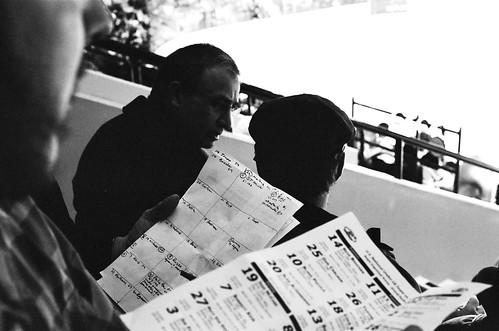Evaluating Player Evaluation: Scouting
By Ryan Pike
10 years ago
The most prominent method in evaluating players – both established and emerging – is by scouting them in-person. The method has its particular strengths and weaknesses, as you would expect. Over the past two seasons I’ve been contributing to the NHL Draft coverage over at The Hockey Writers and I’ve developed some observations based on my limited scouting experiences.
First and foremost, trying to keep track of more than maybe two or three players in a game is tricky. In my first couple outings to Hitmen games to see opposition players, I figured I could get notes on everybody. Generally-speaking, the more players you try to follow, the less you will actually see. Consequently, the opposite is also somewhat true. I developed an appreciation for Morgan Klimchuk’s two-way play during a fairly one-sided Calgary/Regina tilt where I only paid attention to Klimchuk. As a result, I tend to only “target” one or two players per game.
Secondly, if you want to figure out how good a player really is, you need to see him over and over again and in different situations. The draft-eligible player I saw the most of this season was Calgary Hitmen forward Greg Chase. I saw him on the power-play, short-handed, at even strength, in games that Calgary won handily and in games where the Hitmen just played bad. On the other hand, I saw Eric Roy and Morgan Klimchuk much less often. Thus, I feel less comfortable making broad statements about them as I do about Chase – who was a steal for the Oilers in the seventh round.
Chase’s situation was fairly unique, in that he played top-six minutes for most of the year, but was behind a few older players on the Hitmen depth chart. As such, he didn’t get sheltered as much as other players were, but he got the high ground more often than, say, Jake Virtanen did. This is all a round-about way of noting that a lot of times, you need to see a player in person to know what they can do, and it’s only really useful if you see them in a lot of different circumstances and over the course of a season, especially if a team’s circumstances change. For instance, the Hitmen changed how they deployed players when Jake Virtanen was at the U-17s last year, as well as when they had a slew of injuries during the stretch drive.
Does scouting tell you something? Definitely. In fact, it’s the most data rich scouting tool available.
But compared to statistics, scouting takes a long time to get right, particularly given how much circumstances can skew things and it can be complicated by certain subjectivitiesand biases. If anything, that’s the beauty of having the two approaches – they can complement each other rather nicely, if used and framed properly. The folly is claiming that either approach is superior, as they can’t really be compared because they tend to tell you different things about different parts of a player’s game. Stats can tell me how good Max Reinhart’s NHLE was throughout last year, but scouting can tell me that he became a huge part of the Abbotsford attack after the lockout took Sven Baertschi, T.J. Brodie and Roman Horak out of the Heat line-up, or provide some insight into his on-ice tendencies in different game situations. Both are valuable tools for assessing, evaluating and projecting players.
Evaluating Player Evaluation Series
- NHLE
- Scouting
Recent articles from Ryan Pike





